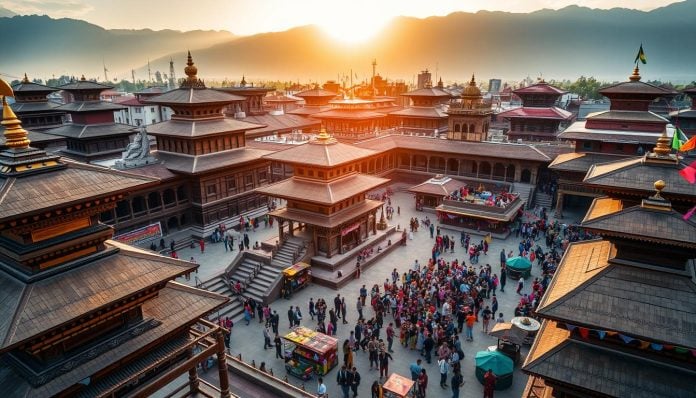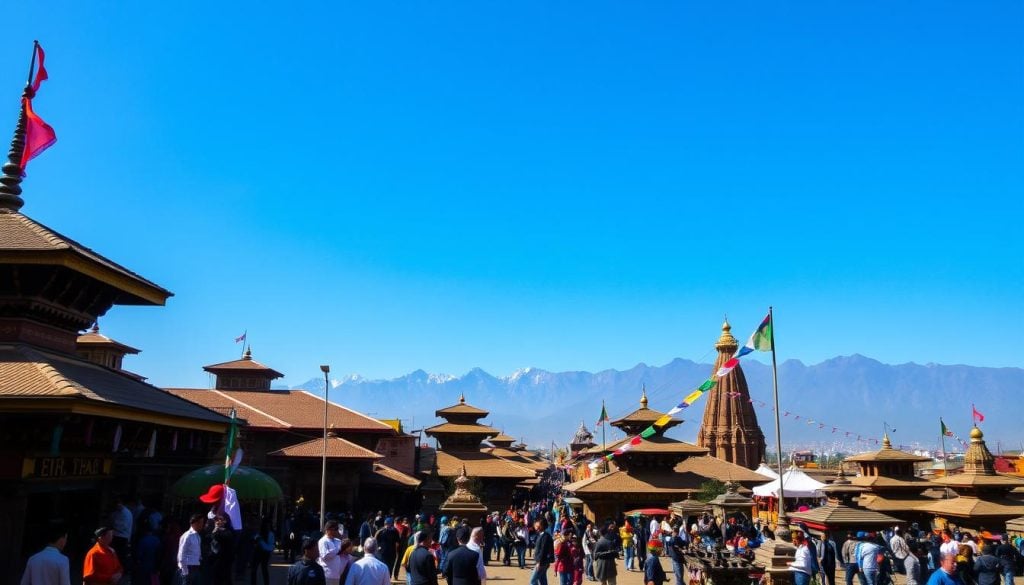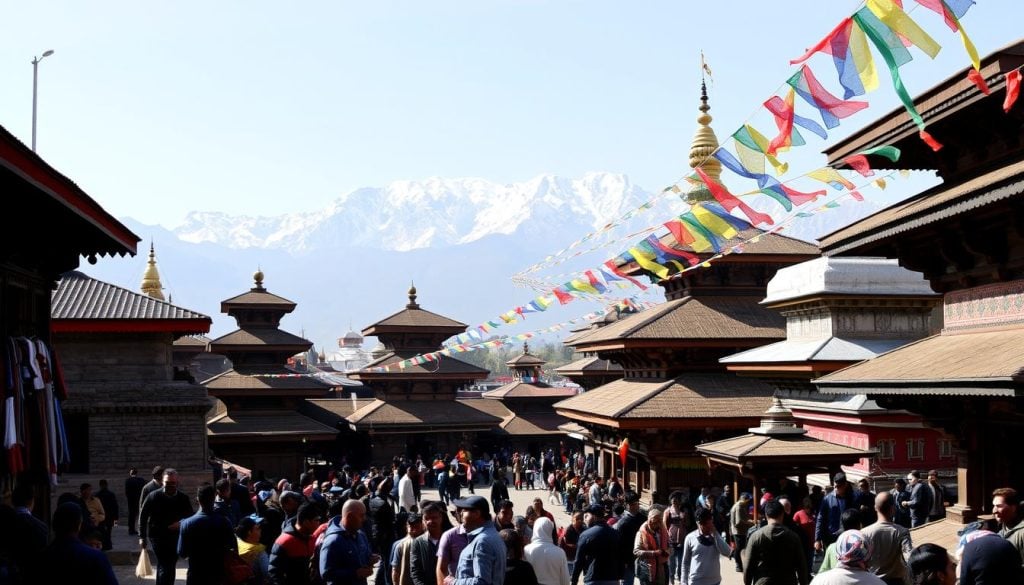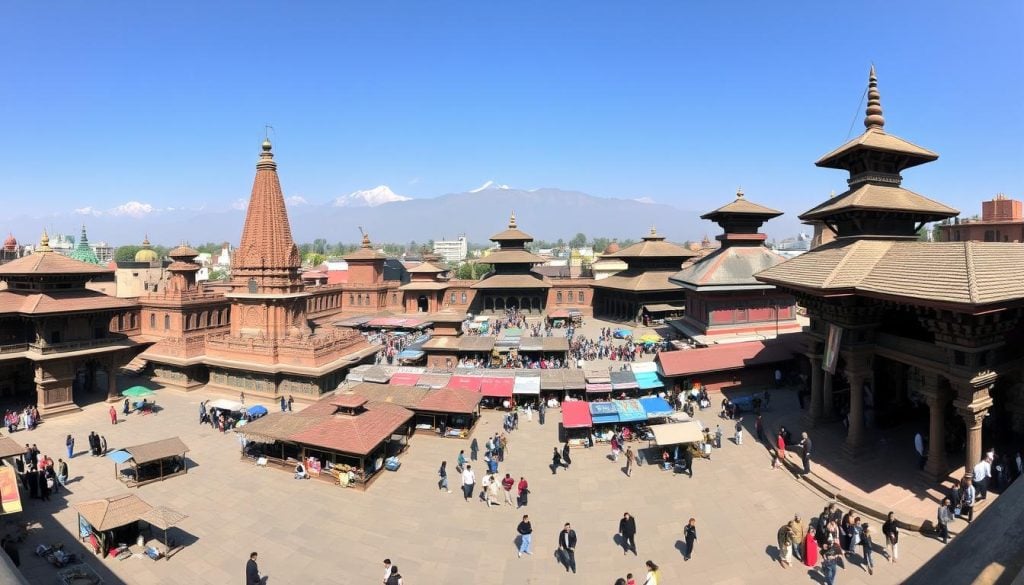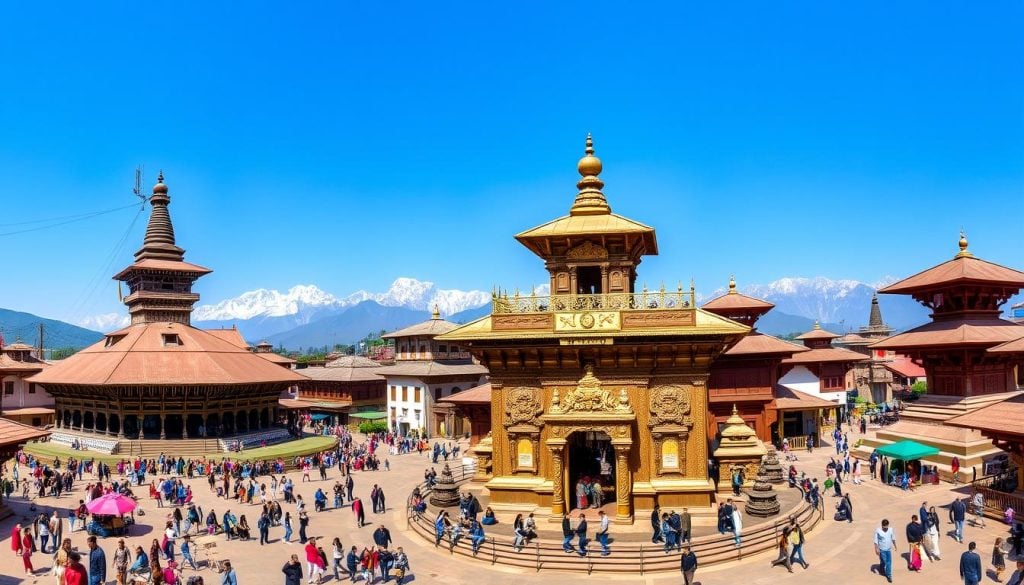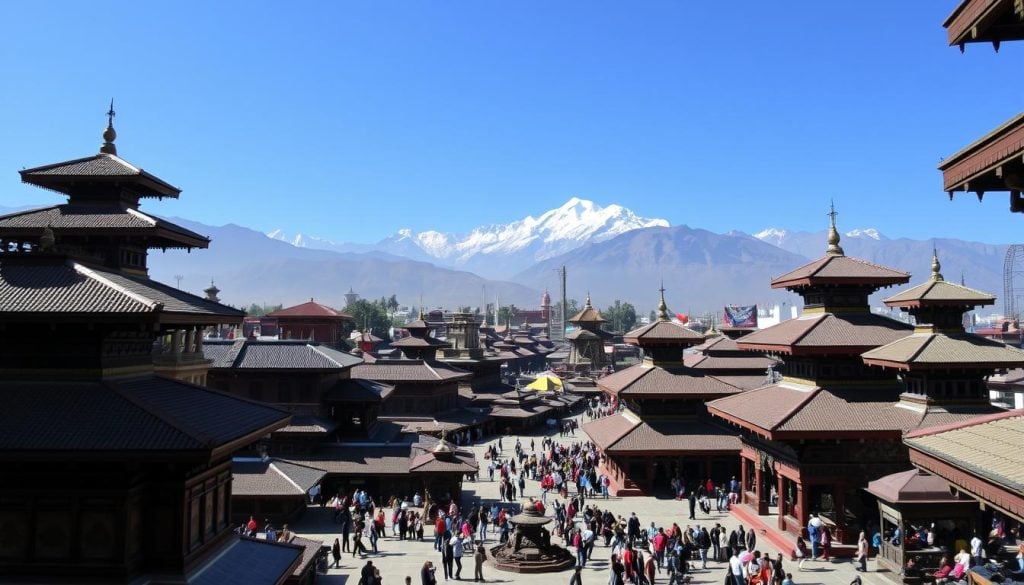Have you ever thought about how one place can hold centuries of history, art, and royal traditions? Kathmandu Durbar Square, once known as Hanuman Dhoka, is a stunning example of Nepal’s cultural heritage. It’s a UNESCO World Heritage Site and the heart of the royal palaces of Kathmandu.
This site has seen the glory of Malla and Shah kings, dating back to the 4th century. Its detailed architecture and historical landmarks tell the story of Nepal’s society and craftsmanship from the 12th to 18th centuries.
Introduction to Kathmandu Durbar Square
Kathmandu Durbar Square is the heart of the capital city, filled with history and culture. It’s a key Nepal historical site in the midst of busy streets. The square is famous for its beautiful temples and palaces, showing Nepal’s royal past.
Here, you’ll see many historical landmarks in Kathmandu. Each one shows the skill and design of its time. The square is a cultural center with temples for many Hindu gods, highlighting Nepal’s spiritual side.
The detailed carvings and designs at Kathmandu Durbar Square are truly special. They attract visitors and scholars. This place is a must-see for anyone wanting to learn about Nepal’s history, art, and faith.
Significance of Kathmandu Durbar Square in Nepal
Kathmandu Durbar Square is more than just a place to visit. It’s the heart of Nepal’s culture. It shows the royal heritage of Nepal through its ancient buildings.
The square is a key spot for social and religious events in Kathmandu. It hosts many festivals that celebrate local traditions. These events bring people together and strengthen community ties.
Kathmandu Durbar Square is a treasure trove of history. It attracts visitors from all over. It’s a symbol of Nepal’s unity and pride, inviting you to explore its rich past.
Overview of Kathmandu Durbar Square History
The Kathmandu Durbar Square history spans centuries, showing a mix of culture and politics. It started in the 3rd century with the Licchavi period. But most of what we see today was built between the 12th and 18th centuries.
It was once a royal palace area. The Malla dynasty kings ruled from Hanuman Dhoka. It was key for governance and public life, showing its importance in Kathmandu’s history.
After Nepal united in 1769, the square remained the royal court. It changed when the Narayan Hiti Palace was built in the late 19th century. It has seen many ancient palaces Kathmandu has seen big religious and cultural changes.
Now, Kathmandu Durbar Square is a symbol of the city’s lasting legacy. Palaces, temples, and monuments tell the story of Kathmandu’s past. Its beauty and history attract both locals and visitors.
Architectural Styles of Kathmandu Durbar Square
Exploring Kathmandu Durbar Square shows the rich culture of Nepal. The mix of traditional Newar architecture and historical influences is stunning. You’ll see how detailed designs and history come together in the square’s buildings.
Traditional Newar Architecture
Newar architecture is a key feature of Kathmandu Durbar Square. It’s known for its detailed woodwork and beautiful facades. The work of Newar artisans is clear in the carved windows and doors.
The buildings are not just pretty. They also serve practical purposes. This shows the balance between beauty and function.
Influence of Malla and Shah Periods
The Malla dynasty left a big mark on the area’s architecture. Many temples and buildings from this time are symbols of Nepal’s culture. The Malla and Shah periods brought new designs while keeping traditional elements.
This mix of styles tells the story of Durbar Square’s evolution. It shows how different times have shaped the area.
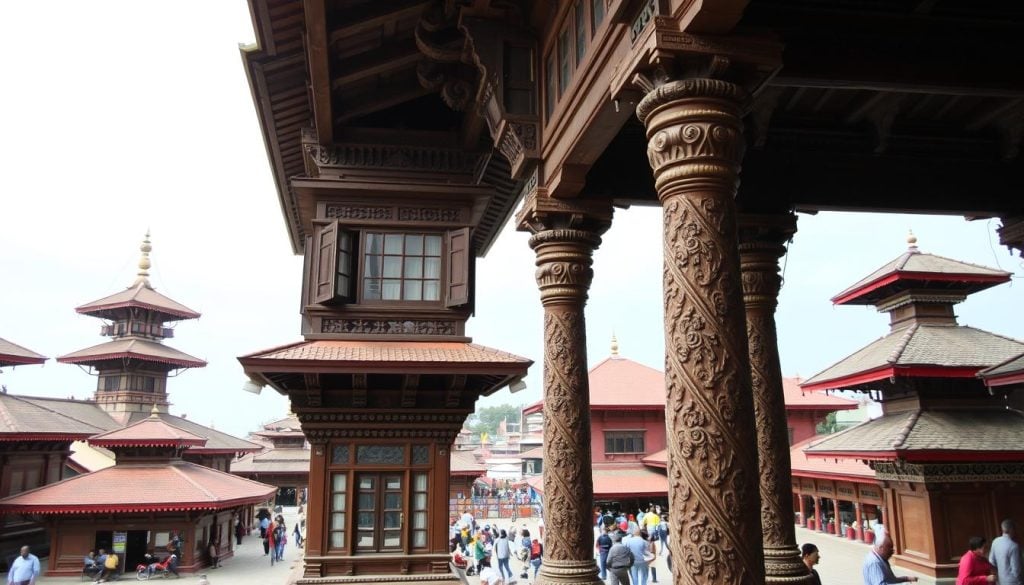
Key Historical Landmarks in Kathmandu Durbar Square
Kathmandu Durbar Square is a vibrant tapestry of culture and history. It features remarkable landmarks that draw visitors from around the globe. Each landmark has a unique story, reflecting Nepal’s rich heritage.
Basantapur Durbar (Nine-Storeyed Palace)
The Basantapur Palace, known as the Nine-Storeyed Palace, showcases Newar architecture. It was once the royal family’s home. Its intricate carvings and decorated windows are a sight to behold.
Visitors are amazed by its grandeur. They learn about its role in Nepal’s royal history.
Taleju Temple and Its Historical Importance
The Taleju Temple was built in the 16th century. It’s dedicated to the goddess Taleju Bhawani. The temple’s Newari architecture is stunning, with detailed stonework and wood carvings.
It reflects the spiritual heart of Kathmandu. It shows the importance of deities in daily life.
The Kumari Ghar and the Tradition of Living Goddesses
The Kumari Ghar is the home of the living goddess. This tradition involves a young girl who embodies the goddess Taleju. She is revered as a living deity.
Visitors are captivated by this unique tradition. It offers a deep connection to Nepal’s cultural practices.
| Landmark | Year Established | Significance |
|---|---|---|
| Basantapur Palace | Late 18th century | Royal residence showcasing Newar architecture |
| Taleju Temple | 16th century | Dedicated to the goddess Taleju Bhawani |
| Kumari Ghar | 19th century | Residence of the living goddess Kumari |
Royal Palaces of Kathmandu
The royal palaces of Kathmandu show the city’s deep history and culture. In the Malla era, these grand buildings were more than homes. They were centers of government and big events. Today, visitors can see the amazing architecture and designs that show the era’s skill.
These palaces went through two main changes. First, the Malla royal complexes were built. Then, the royal family moved to the Narayan Hiti Palace.
Palace Complexes During the Malla Era
The Malla royal complexes are famous for their beauty and history. These buildings were the heart of the Malla kings’ rule. They mixed art and function perfectly.
The Hanuman Dhoka Palace complex is a must-see. It has beautiful carvings and courtyards. These palaces were not just homes but also places of cultural events.
The Shift to the Narayan Hiti Palace
In 1896, the royal family moved to the Narayan Hiti Palace. This change showed the monarchy’s move towards modern times. The Narayan Hiti Palace has big grounds and a fancy design.
It shows how the royal family’s life changed. Today, visitors can see how Narayan Hiti Palace is different from the old Malla palaces. It shows the shift in politics and lifestyle.
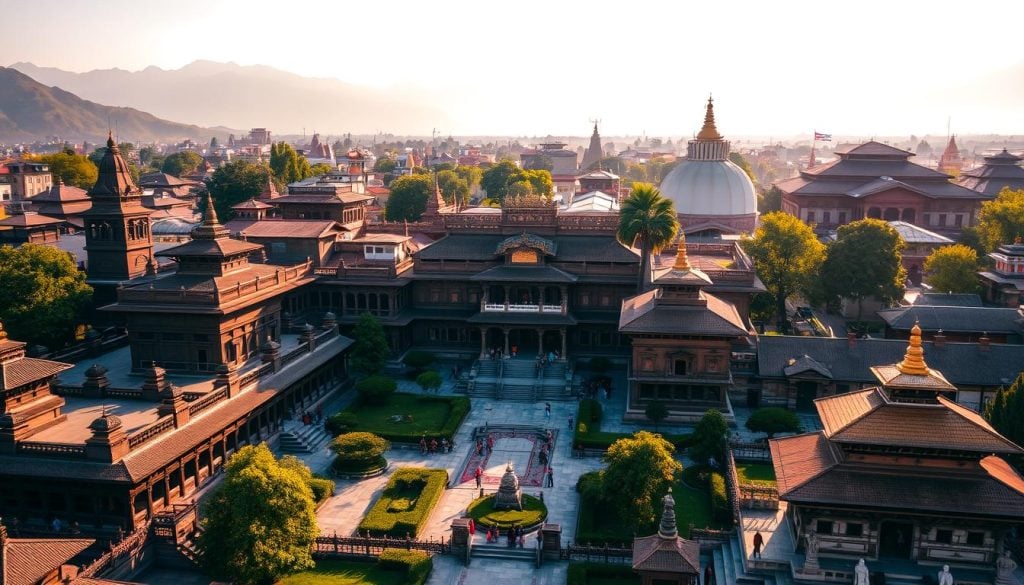
Kathmandu Durbar Square: A UNESCO World Heritage Site
Kathmandu Durbar Square is a UNESCO World Heritage Site, recognized in 1979. This honor highlights its historical and cultural importance. It’s a key place for preserving Nepal’s heritage.
The square features temples, palaces, and monuments. These show centuries of art, architecture, and tradition.
Being on the UNESCO list shows how vital it is to protect Kathmandu Durbar Square. As you walk through, you’ll see lively rituals and festivals. These show the community’s spiritual and social life.
This UNESCO site draws visitors from all over. It helps people understand Nepal’s cultural legacy. The site connects the past with today, keeping Kathmandu’s heritage alive for the future.
It’s crucial to protect this square. It’s not just a historical treasure but also a living example of Nepali resilience and creativity.
Impact of the 2015 Earthquake on Kathmandu Durbar Square History
The 2015 earthquake in Nepal hit Kathmandu Durbar Square hard. This UNESCO World Heritage Site is full of cultural treasures. The quake damaged many historical buildings, especially the famous Kasthamandap.
This disaster showed how vulnerable these old buildings are. It also started a big talk about how to protect them better.
Damage to Historical Structures
Many buildings in Kathmandu Durbar Square were badly damaged by the earthquake. This worried historians and those who care about saving old places. The damage changed the look of the square and threatened its cultural stories.
It made people realize how important it is to fix these sites. They need to be saved for the future.
Restoration Efforts Post-Earthquake
After the earthquake, a big effort started to fix Kathmandu Durbar Square. The goal is to bring back its beauty and make it stronger against earthquakes. They use old skills and new methods to do this.
This work aims to keep the square’s history alive. It lets us see its beauty again and learn from it for years to come.

































